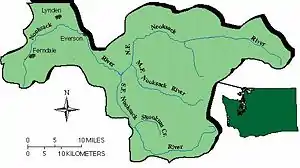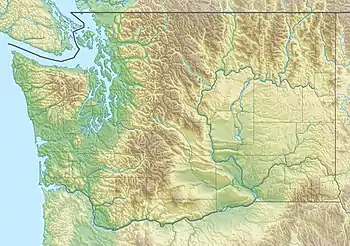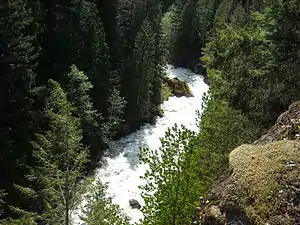Nooksack River
The Nooksack River is a river in the northwest part of the U.S. state of Washington. It drains an area of the Cascade Range around Mount Baker, near the Canada–US border. The lower river flows through a fertile agricultural area before emptying into Bellingham Bay and, via the Strait of Juan de Fuca and the Strait of Georgia, the Pacific Ocean. The river begins in three main forks, the North Fork, Middle Fork, and South Fork. The North Fork is sometimes considered the main river.[1] Including the North Fork, the Nooksack is approximately 75 miles (121 km) long. All three forks originate in the Mount Baker Wilderness.
| Nooksack River North Fork Nooksack River | |
|---|---|
 Aerial Photo of the river in Ferndale, WA. | |
 Nooksack Basin | |
 Mouth of the Nooksack River in Washington | |
| Location | |
| Country | United States |
| State | Washington |
| Counties | Whatcom |
| Cities | Ferndale, Marietta |
| Physical characteristics | |
| Source | Cascade Range |
| • location | Mount Baker Wilderness |
| • coordinates | 48°50′0″N 121°33′18″W[1] |
| • elevation | 3,620 ft (1,100 m)[2] |
| Mouth | Bellingham Bay |
• coordinates | 48°46′29″N 122°35′57″W[3] |
• elevation | 0 ft (0 m)[2] |
| Length | 75 mi (121 km)[4] |
| Basin size | 786 sq mi (2,040 km2)[5] |
| Discharge | |
| • location | Ferndale[5] |
| • average | 3,814 cu ft/s (108.0 m3/s)[5] |
| • minimum | 466 cu ft/s (13.2 m3/s) |
| • maximum | 48,200 cu ft/s (1,360 m3/s) |
| Basin features | |
| Tributaries | |
| • left | Wells Creek, Glacier Creek, Middle Fork Nooksack River, South Fork Nooksack River |
| • right | Canyon Creek |
Course
North Fork
The North Fork Nooksack River rises at the Nooksack Cirque in central Whatcom County, north of Mount Shuksan in the western part of North Cascades National Park. Gathering melt water off of East Nooksack Glacier, it flows generally west, passing north of Mount Baker. For most of its course the North Fork is paralleled by State Route 542 (also called the Mount Baker Highway).
Flowing west from the Nooksack Cirque, the river picks up large creeks such as Price Creek, a short creek draining Price Lake, as well as Ruth Creek, before flowing under the uppermost highway bridge.

At Nooksack Falls the river flows through a narrow valley and drops freely 88 feet (27 m) into a deep rocky river canyon. The falls are viewable from the forested cover near the cliff edge. A small parking lot nearby contains a kiosk with information about the falls and a hydroelectric project.
Continuing to flow west, the North Fork receives several tributaries including Wells Creek, which joins the river right at the base of the falls as well as Glacier Creek, and Canyon Creek, before the river turns briefly south. The Middle Fork and South Fork join within a few miles of one another. The Middle Fork joins first, creating the Nooksack River proper. The South Fork joins just east of Deming in the Nooksack Indian Reservation.

The traditional name of the North Fork in the Nooksack language is Chuw7álich ("the next point").[6]
Middle Fork
The Middle Fork Nooksack River, about 20 miles (32 km) long, originates on the southern slopes of Mount Baker near Baker Pass.[7] It flows generally northwest between Mount Baker and Twin Sisters Mountain.
The traditional name of the Middle Fork in the Nooksack language is Nuxwt’íqw’em ("always-murky water").[6]
South Fork
The South Fork Nooksack River, about 50 miles (80 km) long, rises in southern Whatcom County, east of Twin Sisters Mountain near Bell Pass and Lake Wiseman.[8] It flows briefly south, entering Skagit County, then northwest and north, reentering Whatcom County and flowing by Acme.
The traditional name of the South Fork in the Nooksack language is Nuxw7íyem ("always-clear water").[6]
Nooksack River
After the Middle and South Forks join, the combined river flows northwest, emerging from the mountains and flowing past Everson and Lynden. Near Everson, the river is at risk of floods breaching the right bank, allowing flow into lower lands to the north, through Sumas River and into Canada. At Lynden the river turns southwest and then, near Ferndale, south, to enter the north side of Bellingham Bay at the Lummi Indian Reservation, approximately 3 miles (4.8 km) west of Bellingham.[9]
The river is subject to flooding due to high rainfall amounts and some of the deepest snow packs in the country, sometimes triggered by a Pineapple Express, a weather pattern that brings central Pacific wind and rain to the northwest. One such storm flooded the city of Everson on November 7, 2006.[10]

River modifications
The river currently supplies the nearby town of Glacier with hydroelectric power from a dam near Nooksack Falls on the North Fork. The Middle Fork was also partially blocked with a diversion dam built by the City of Bellingham in the late 1950s for diverting water into Lake Whatcom, Bellingham's drinking water supply. As of July 2020, this old water diversion system has been modified to remove the dam and restore the river channel for the benefit of critical salmon spawning habitat. [11]
In the late 19th century, most of the stream flow of the Nooksack River near its mouth flowed through the present channel of the short Lummi River to Lummi Bay, northwest of Bellingham Bay. Near the start of the 20th century, a log jam plugged the channel to Lummi Bay, forcing the river to change its channel to the present one. The accumulation of the new river delta has been an ongoing field of research regarding the new wetlands it has created while no longer resupplying the previous delta on Lummi Bay, except during high flow conditions.
See also
References
- U.S. Geological Survey Geographic Names Information System: Nooksack River
- Google Earth elevation for GNIS coordinates.
- U.S. Geological Survey Geographic Names Information System: Nooksack River
- Nooksack River Archived 2004-07-02 at the Wayback Machine, The Columbia Gazetteer of North America.
- Nooksack River Basin, Water Resource Data, Washington, 2005, USGS.
- "Cultural Resources Department". NookSack Indian Tribe. Archived from the original on 2014-01-04. Retrieved 2013-09-16.
- U.S. Geological Survey Geographic Names Information System: Nooksack River
- U.S. Geological Survey Geographic Names Information System: Nooksack River
- Course info mainly from: Washington Road & Recreation Atlas. Benchmark Maps. 2000.
- Blumenthal, Les (October 12, 2008). "Endangered species ruling could slow development in floodplains". The News Tribune. Tacoma News, Inc. Retrieved 2008-10-12.
- "Bang! Watch a Nooksack River dam finally coming down, freeing miles for fish habitat". The Seattle Times. 2020-07-20. Retrieved 2020-08-04.